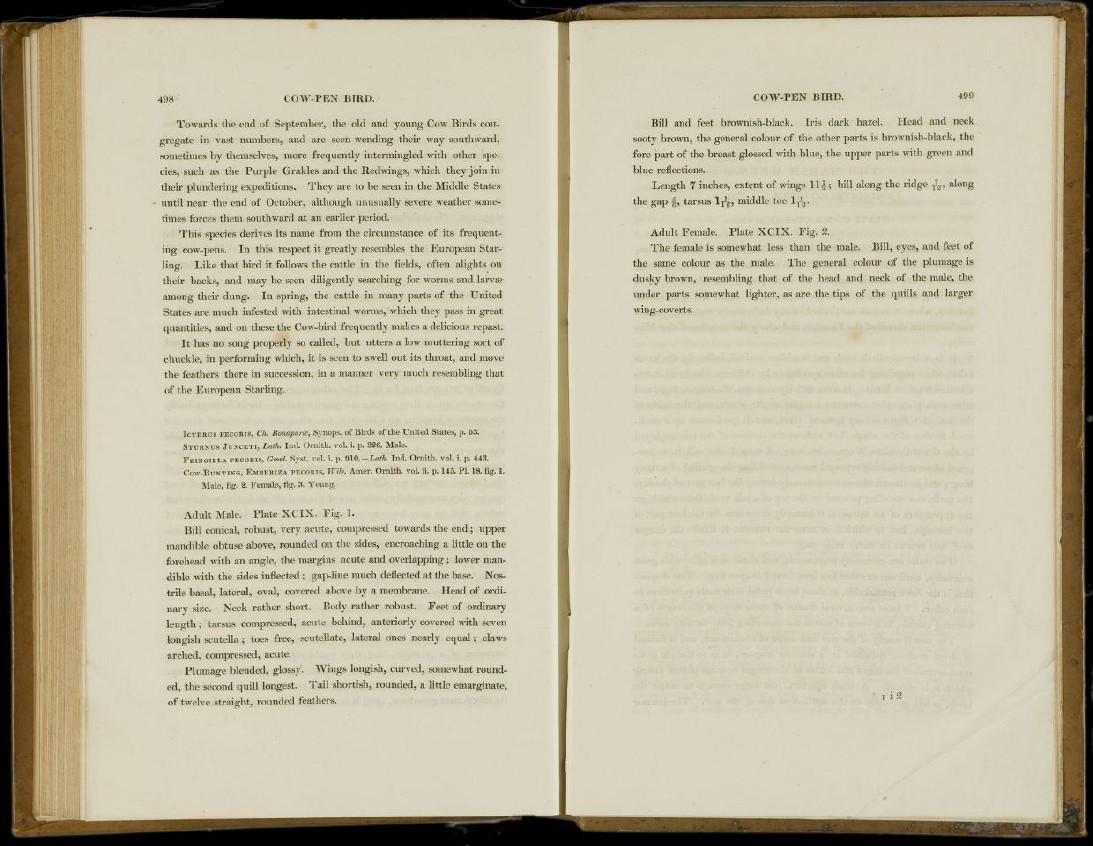
Towards the end of September, the old and young Cow Birds congregate
in vast numbers, and are seen wending their way southward,
sometimes by themselves, more frequently intermingled with other species,
such as the Purple Grakles and the Redwings, which they join in
their plundering expeditions. They are to be seen in the Middle States
until near the end of October, although unusually severe weather sometimes
forces them southward at an earlier period.
This species derives its name from the circumstance of its frequenting
cow-pens. In this respect it greatly resembles the European Starling.
Like that bird it follows the cattle in the fields, often alights on
their backs, and may be seen diligently searching for worms and larvae
among their dung. In spring, the cattle in many parts of the United
States are much infested with intestinal worms, which they pass in great
quantities, and on these the Cow-bird frequently makes a delicious repast.
It has no song properly so called, but utters a low muttering sort of
chuckle, in performing which, it is seen to swell out its throat, and move
the feathers there in succession, in a manner very much resembling that
of the European Starling.
ICTERUS PECORIS, Ch. Bonaparle, Synops. of Birds of the United States, p. 53.
STURNUS JUNUETI, Lath. Ind. Ornith. vol. i. p. 32G. Male.
FHINGII.I.A PECORIS, Gmel. Syst. vol. i. p. 9 1 0 .— Lath. Ind. Ornith. vol. i. p. 443.
COW-BUNTING, EMRERIZA PECORIS, Wilt. Amer. Ornith. vol. ii. p. 145. PI. 19. fig. 1.
Male, fig. 2. Female, fig. 3 . Young.
Adult Male. Plate XCIX. Fig. 1 .
Bill conical, robust, very acute, compressed towards the end; upper
mandible obtuse above, rounded on the sides, encroaching a little on the
forehead with an angle, the margins acute and overlapping; lower mandible
with the sides inflected; gap-line much deflected at the base. Nostrils
basal, lateral, oval, covered above by a membrane. Head of ordinary
size. Neck rather short. Body rather robust. Feet of ordinary
length; tarsus compressed, acute behind, anteriorly covered with seven
longish scutella; toes free, scutellate, lateral ones nearly equal; claws
arched, compressed, acute.
Bill and feet brownish-black. Iris dark hazel. Head and neck
sooty brown, the general colour of the other parts is brownish-black, the
fore part of the breast glossed with blue, the upper parts with green and
blue reflections.
Length 7 inches, extent of wings 1 H ; bill along the ridge fa along
the gap f, tarsus ly^, middle toe 1T^.
Adult Female. Plate XCIX. Fig. 2.
The female is somewhat less than the male. Bill, eyes, and feet of
the same colour as the male. The general colour of the plumage is
dusky brown, resembling that of the head and neck of the male, the
under parts somewhat lighter, as are the tips of the quills and larger
wing-coverts.
Plumage blended, glossy. Wings longish, curved, somewhat rounded,
the second quill longest. Tail shortish, rounded, a little emarginate,
of twelve straight, rounded feathers. i i2